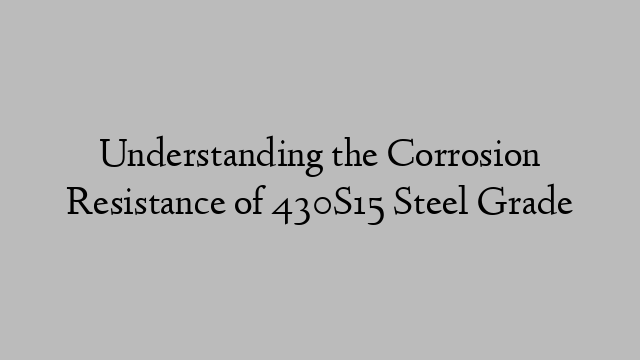Address
304 North Cardinal St.
Dorchester Center, MA 02124
Work Hours
Monday to Friday: 7AM - 7PM
Weekend: 10AM - 5PM
Address
304 North Cardinal St.
Dorchester Center, MA 02124
Work Hours
Monday to Friday: 7AM - 7PM
Weekend: 10AM - 5PM

Steel is one of the most versatile and widely used materials in manufacturing and construction. However, different grades of steel offer different levels of corrosion resistance, which is an important factor to consider when selecting the right material for a particular application. One such grade of steel is 430S15, which is known for its good corrosion resistance properties.
Understanding the corrosion resistance of 430S15 steel grade is crucial in order to make informed decisions about its usage in various applications. So, what exactly is the corrosion resistance of this steel grade, and how does it compare to other grades of steel?
430S15 is a ferritic stainless steel, which means it contains a high amount of chromium (up to 18%) and low carbon content (less than 0.12%). Chromium is the key element that provides the corrosion resistance in stainless steel, as it forms a passive oxide layer on the surface of the steel, which helps protect it from rust and corrosion. Additionally, the low carbon content helps to reduce the formation of carbides, which can decrease the corrosion resistance of the steel.
The corrosion resistance of 430S15 steel grade is quite good in low to moderate exposure to corrosive environments. It is suitable for use in indoor applications, such as kitchen appliances, sinks, and decorative trim. It also performs well in mildly corrosive environments, such as rural and urban atmospheres. However, it is important to note that 430S15 steel is not recommended for use in highly corrosive environments, such as marine or chemical industries, where more corrosion-resistant grades of stainless steel, such as 316 or 304, are often preferred.
To enhance the corrosion resistance of 430S15 steel grade, it can be subjected to various surface treatments and finishes, such as passivation, polishing, and coating. These treatments help to further improve the formation of the passive oxide layer on the surface of the steel, providing additional protection against corrosion.
It is also important to consider the other environmental factors that may affect the corrosion resistance of 430S15 steel grade, such as temperature, humidity, and the presence of certain chemicals. It is essential to evaluate the specific conditions in which the steel will be used to ensure that it will perform adequately in those environments.
In conclusion, 430S15 steel grade offers good corrosion resistance in low to moderate exposure to corrosive environments, making it suitable for a wide range of indoor and outdoor applications. However, it is important to carefully assess the specific requirements of the application and the environmental factors that may affect the steel’s performance in order to make an informed decision about its usage. By understanding the corrosion resistance of 430S15 steel grade, manufacturers and engineers can select the right material for their applications, ensuring long-lasting and reliable performance.